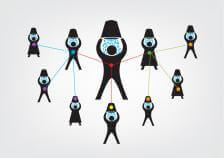Marketing Lessons from the Ice Bucket Challenge
The Ice Bucket Challenge is a viral sensation, and a success story for the ALS Association. The Digital Marketer shares her thoughts about what made it so successful, and offers some tips for creating your own challenge.

With a little bit of Googling, you’ve also probably discovered that the ALS Association had nothing to do with the Ice Bucket Challenge. It’s an accidental beneficiary of viral videos. Despite the disease’s close connection to baseball–it’s commonly known as Lou Gehrig’s disease, after the Yankee first baseman–the Ice Bucket Challenge actually started with professional golfers.
Initially, the idea was to raise money for the golfers’ favorite charities. But when Jeanette Senerchia, the cousin of a professional golf coach, completed the challenge, she donated to the ALS Association. (Her husband has ALS.) She challenged their large circle of friends and family to do the sme, and yhe connection to ALS stuck.
It would be easy to attribute the success of the Ice Bucket Challenge to chance. But if we reverse engineer the campaign, we can identify several characteristics contributing to its success. These characteristics are backed by the observations of Kevin Allocca, Head of Culture and Trends at YouTube.
In his classic 2011 TED Talk, Why Videos Go Viral, Allocca says content goes viral for three reasons: unexpectedness, communities of participation, and tastemakers. The Ice Bucket Challenge has all of these characteristics.
 Why the Ice Bucket Challenge Worked
Why the Ice Bucket Challenge Worked
- New and fresh content creates unexpectedness. The first time you watch an Ice Bucket Challenge video, it’s not immediately clear why someone is pouring ice water over their head. Of course, after the first video, everyone got the concept. But it continues to be interesting because each individual challenge is different. Chris Pratt will surely be funny, but how will the perfectly coiffed Jennifer Steinbrenner’s clothes fare in ice water?
- The second characteristic – communities of participation – is abundantly evident in the Ice Bucket Challenge. It’s extremely easy to recreate: you don’t need much beyond ice water, a bucket, an iPhone, and a link to the ALS Association donation page. This ease of participation has helped it build a strong community around a common cause.
- Tastemakers – those influential individuals who have large established followings – are the main reason the Ice Bucket Challenge spread quickly. Before Senerchia connected the challenge to ALS, “Today” show host Matt Lauer took the challenge. Although his donation went to the Hospice of Palm County, his participation on national television raised awareness of the concept. But it was Pete Frates, the former captain of the Boston College baseball team, who is credited with tipping the viral sensation to ALS. Frates, who has the disease, took the challenge on behalf of ALS and spread it through his network of sports figures and celebrities.
6 Tips for Viral Success
Can digital marketers really replicate the success of this challenge? Creating a challenge with the characteristics above is a start, but a few additional tweaks can optimize the conditions.
For digital marketers looking to replicate the success of the Ice Bucket Challenge, here are six tips to make it happen:
- Make it Easy. Keep your challenge very simple, so that anyone can copy and personalize it.
- Be Surprising. Remember the only things that stand out on the Internet are those that are completely new, unique, and unexpected. Originality works.
- Enable Humor. The outcome of the challenge must have the potential for being funny – each and every time. Laughter is the current of the Internet.
- Create an Ask. In the original challenge, the ask was a donation to a favorite charity. In the ALS challenge, it’s $100 to the ALS charity of your choice, if you refuse to pour cold water over your head, or $10 if you do get doused.
- Tag and Share. The Ice Bucket Challenge required participants to challenge two others and tag them in posts. This was a critical step that pushed the challenge into ever-wider social circles of followers, friends and family.
- Share with influencers. The key to accelerating the spread of the challenge was the involvement of a few well-known salesmen, who hawked it to their loyal followers.
A word of warning: I expect the Ice Bucket Challenge to run out of steam soon. Challenge fatigue is already starting to set in, which means copycats are going to get a chilly reception. If you set out to create your own challenge, put some time between the Ice Bucket Challenge and yours.
Also, don’t create a challenge that is too similar to the Ice Bucket Challenge. The next viral sensation for charity will be something wholly unexpected. So, be original.
Photos of ice bucket figures and Gone Viral sign courtesy of Shutterstock.


 Why the Ice Bucket Challenge Worked
Why the Ice Bucket Challenge Worked



